DUBAI, UAE — The Gulf countries were able to distance themselves from the global chaos caused by geopolitical tensions, the Ukrainian war, the energy crisis, worsening inflation rates, and market volatility in 2022 due to the strong economic performance, according to a report issued by PwC.
According to the report, the Gulf countries’ successful hosting of international events in 2022, such as “Expo Dubai” in the UAE, the World Cup in Qatar, and the Conference of the Parties (COP27) in Egypt, also contributed to this strong performance.
The report revealed that five significant axes and trends must be monitored in 2023 due to their importance to the economies of the Gulf states. These trends are represented in the possibility of the global economy entering a recession. However, the outlook for the Gulf countries in 2023 is more optimistic, with GDP expected to grow by 3.6 percent.
The momentum continues
With the non-oil purchasing managers’ index remaining healthy for much of 2022, the momentum is expected to continue rapidly, especially as the Gulf economies diversify.
On the other hand, the report indicated that the US Federal Reserve’s rapid rate of raising interest rates reflected significant pressure on market liquidity in the Gulf region, but this will change as a result of corrective measures in 2023.
With attention focused on the UAE’s hosting of COP28 later this year, the region’s countries will likely find greater motivation to move forward with more reforms related to commitments to achieve carbon neutrality.
The final axis that the report recommends monitoring in 2023 is the Gulf countries’ increased emphasis on nationalizing the workforce in the private sector, particularly in Saudi Arabia and the UAE.
Inflation has decreased
Inflation remains a significant issue in many countries around the world. For example, in the Gulf region, while inflation reached its highest level in 11 years in July at 4.8 percent, it fell to 4 percent in November and is expected to fall further to 2.7 percent in 2023.
According to PwC, the main reasons for this decline are subsidies and price controls for fuel, electricity, and food, as well as the strength of the US dollar, to which most Gulf countries’ currencies are pegged, which limited import price inflation in a region that relies heavily on commodities.
The Gulf region’s modest inflation rates indicate that there is no urgent need to mitigate this inflation through monetary policy interventions. Nonetheless, pegging currencies to the dollar means that Gulf countries must keep up with rising US interest rates to avoid capital inflows to the outside.
Non-oil sector expansion
Regarding growth trends in 2023, the “PwC” report stated that the most recent data available for the Q3 2022 show solid growth for the non-oil sectors in Saudi Arabia, UAE, and Bahrain, while Oman experienced a -1 percent annual contraction as a result of the construction sector’s weakness (which fell by -22 percent y/y) since the beginning of the year. Other non-oil sectors grew by 4.2 percent excluding this sector.
The report revealed that Saudi Arabia, in particular, has a strong momentum bolstered by government expenditures and economic reforms, as each of the sectors returned to pre-COVID-19 levels in the third quarter, while non-oil sectors as a whole grew by 8.4 percent. Although some sectors in other Gulf countries, particularly transportation and hospitality, have yet to fully recover, they are making significant progress.
Financial surplus
After the Gulf states recorded a deficit of 10 percent of GDP in 2022, which was considered their worst year since the early 1990s oil price slump – and it was the seventh consecutive annual regional deficit – the pace of recovery was rapid.
Saudi Arabia achieved its first budget surplus in 9 years, amounting to $27.1 billion, equivalent to 2.6 percent of GDP in 2022, within the framework of the fiscal balance program.
According to “PwC,” this shift is primarily due to continuous expenditure control. One of the reasons for optimism is that Gulf governments adhere to basic areas of strict spending restrictions, which are difficult to reverse. Salaries in Saudi Arabia, for example, increased by only 2 percent over the past year, returning to 2019 levels, while current basic expenditures in Oman (excluding subsidies and gas purchases) increased by only 2 percent.
Stable tax policies
The budgets released so far revealed another positive aspect on the financial level: the absence of fluctuations in tax policy or significant new measures. Saudi Arabia has kept its VAT rate at 15 percent, though Crown Prince Mohammed bin Salman indicated in 2021 that it would be reduced at some point. Bahrain, for its part, increased the value-added tax rate to 10 percent, while the UAE passed legislation in December establishing a 9 percent corporate tax that will go into effect in June 2023. In Oman, parliament has begun debating a draft of personal income tax law, the first of its kind in the region.








